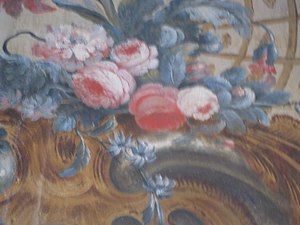
Agneta Wrede's vestibule is a room in the upper floor of Åkeshov Palace in Bromma, outside Stockholm, Sweden. The room is named after Baroness Agneta Wrede af Elimä (1718–1800), and who lived in the palace during 1747–1800. The room is richly decorated and painted in Rococo style. The decoration of the suite depicts a rural idyll. The entire interior remains authentic.
History
In 1720, Åkeshov palace was bought by the at the time Chancellor of Justice, Baron Gabriel Stierncrona, who converted it with subordinate farms in Spånga and Järfälla parishes. The next owner was the then only eight-year-old son David.
The paintings in Agneta Wrede's vestibule were stored at the beginning of the 20th century, but were later found after many years in the attic of St. Erik's hospital.
Stockholm City Museum spearheaded an effort to return the paintings to their original setting. During the restoration, Agneta Wrede's vestibule were restored and the paintings in the upper hall skillfully copied by the artist John Broberg and Brita Juel-Soop.
Gallery
-
 Agneta Wrede's atrium
Agneta Wrede's atrium
-
 Agneta Wrede's atrium 2
Agneta Wrede's atrium 2
-
 The eastern part with the long wall
The eastern part with the long wall
-
 The long wall
The long wall
-
 The western part
The western part
References
- ^ Selling, Gösta (1977). Säterier och gamla gårdar i stockholmstrakten (Ny, omarb. o. väsentlight utvidgad uppl ed.). Stockholm: Bonnier. ISBN 978-91-0-039434-9.
- "Österskär 100 år - Specialnummer av Hembygdsföreningens tidning "Milstolpen" 6/2004 genom Olle Löfgren" (in Swedish). 2013-10-20. Archived from the original on 2013-10-20. Retrieved 2024-03-25.
- ^ Sörenson, Ulf; Söderström, Göran (2009). Vägvisare till Stockholm: en kulturguide. Stockholm: Lind & Co. ISBN 978-91-85801-62-6.
- ^ "Om oss – Åkeshofs Slott i Bromma – välkommen till det lilla slottet!". Åkeshofs Slott. Retrieved 2024-03-25.
59°20′27″N 17°55′29″E / 59.34083°N 17.92472°E / 59.34083; 17.92472
Categories: